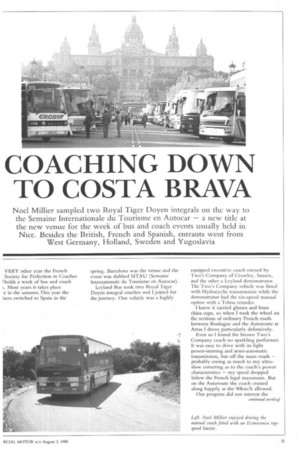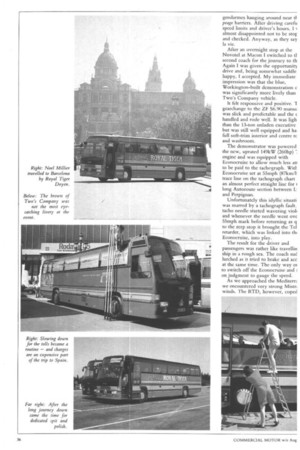COACHING DOWN TO COSTA BRAVA
Page 39

Page 40

Page 41

If you've noticed an error in this article please click here to report it so we can fix it.
Noel Millier sampled two Royal Tiger Doyen integrals on the way to the Semaine Internationale du Tourisme en Autocar — a new title at the new venue for the week of bus and coach events usually held in Nice. Besides the British, French and Spanish, entrants went from West Germany, Holland, Sweden and Yugoslavia
VERY other year the French Society for Perfection in Coaches !holds a week of bus and coach ;. Most years it takes place :e in the autumn.This year the isers switched to Spain in the spring. Barcelona was the venue and the event was dubbed SITAU (Sem aine Internationale du Tourisme en Autocar).
Leyland Bus took two Royal Tiger Doyen integral coaches and I joined for the journey. One vehicle was a highly equipped executive coach owned by Two's Company of Crawley, Sussex, and the other a Leyland demonstrator. The Two's Company vehicle was fitted with Hydracyclic transmission while the demonstrator had the six-speed manual option with a Telma retarder.
I knew it carried glasses and bone china cups, so when I took the wheel on the sections of ordinary French roads between Boulogne and the Autoroute at Arras I drove particularly defensively.
Even so I found the brown Two's Company coach no sparkling performer. It was easy to drive with its light power-steering and semi-automatic transmission, but off the main roads — probably owing as much to my ultraslow cornering as to the coach's power characteristics — my speed dropped below the French legal maximum. But on the Autoroute the coach cruised along happily at the 90km/h allowed.
Our progress did not interest the
gendarmes hanging around near a peage barriers. After driving carefu speed limits and driver's hours, I almost disappointed not to be stor and checked. Anyway, as they say la vie.
After an overnight stop at the Novotel at Macon I switched to tl second coach for the journey to th Again I was given the opportunity drive and, being somewhat saddle happy, I accepted. My immediate impression was that the blue, Workington-built demonstration c was significantly more lively than Two's Company vehicle.
It felt responsive and positive. 1 gearchange to the ZF S6.90 mantN was slick and predictable and the handled and rode well. It was ugh than the 13-ton unladen executive but was still well equipped and ha. full soft-trim interior and centre tc and washroom.
The demonstrator was powered the new, uprated 149kW (260hp) 7 engine and was equipped with Econocruise to allow much less au to be paid to the tachograph. With Econocruise set at 55mph (87km/1-. trace line on the tachograph chart an almost perfect straight line for long Autoroute section between L and Perpignan.
Unfortunately this idyllic situati. was marred by a tachograph fault. tacho needle started wavering viol' and whenever the needle went ove 55mph mark before returning as q to the zerp stop it brought the Tel retarder, which was linked into thi Econocruise, into play.
The result for the driver and passengers was rather like travellin ship in a rough sea. The coach sud lurched as it tried to brake and ace at the same time. The only way oi to switch off the Econocruise and I on judgment to gauge the speed.
As we approached the Mediterrz we encountered very strong Mistr; winds. The RTD, however, coped
mained pleasantly controllable. I the journey in the demonstrator omfortable from both a passenger's e driver's points of view and the :y was marred only by the tacho which was rectified by a Keinzle in Spain, and a fault in the coach A similar fault occurred on a ,us RTD journey to Nice a year
:e in Barcelona we went to the ine-up between the city's main tion halls.
AU coincided with Rodatur, a ;h travel industry exhibition being
-1 an adjacent exhibition hall.
ur included a display of new ;h coaches.
pite attracting only around 40 ;, SITAU lived up to its ational title with coaches there France, West Germany, Holland, Britain, Spain, Sweden and
ilavia on display. This year the
g and moving technical tests were !d. But a road section for coaches oaded with passengers was led and this started at the historic h town of Nimes. Much to the in of the tourist office there, the h coaches entered did not take part ; part of the event.
Iddition to the two Leylands, n was also represented by an Metro-Hi-Liner of Premier 1 Services of Cambridge.
road section of the event resulted e between two Setras operated by of Heilbron, of West Germany. :he safety section of the concourse etition the Royal Tiger Doyen ommended for its driving artment. The winner in this section Swedisn-registered Scania K112 with a new Finnish-built Ajoklci 1 body.
:he class for tourist coaches first was awarded to Volvo's ClOM .2.1 and second place to the ItalianVolvo entry the Italia 99-bodied I. The MCW took sixth place in ss.
award for grand touring coaches to Kassbehrer for a Setra i-IDS high-deck coach built illy for the event. The Ajokki 11 Scania took second place in this






















































































